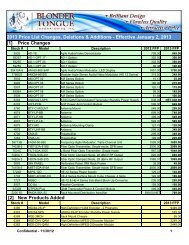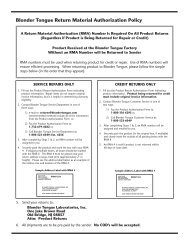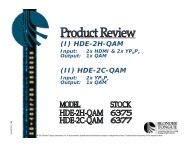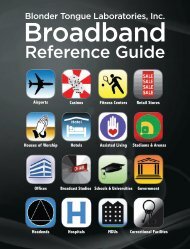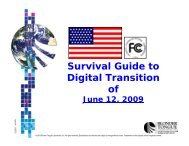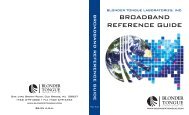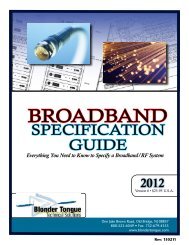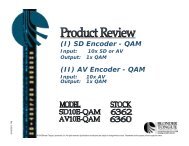Functional Block Diagram - Blonder Tongue Laboratories Inc.
Functional Block Diagram - Blonder Tongue Laboratories Inc.
Functional Block Diagram - Blonder Tongue Laboratories Inc.
Create successful ePaper yourself
Turn your PDF publications into a flip-book with our unique Google optimized e-Paper software.
Broadband Specification Guide<br />
Hybrid Fiber and Coax Distribution<br />
<strong>Functional</strong>ity<br />
This type of distribution system is the link between the source (Headend) and the televisions that are<br />
scattered throughout the facility. This network relies on a combination of single mode fiber optic cable and<br />
traditional coaxial cable to distribute the desired signals.<br />
In Depth Description<br />
This network provides a degree of future proofing, due to the virtually unlimited capacity of the single mode<br />
fiber optic cable. The architecture starts out exactly the same as the “Star” architecture described under<br />
coaxial distribution with a minor change. The signal that is going to be distributed through out the facility is<br />
given to a fiber optic transmitter for conversion to light.<br />
The transmitter must be correctly sized in order to overcome the loss of the splitter network and the fiber<br />
network, and still provide enough signal to the fiber optic receivers. The optical output is then given to an optical<br />
splitter network to provide enough outputs for the network. These outputs are connected to single mode<br />
fiber optic cables, instead of coaxial trunk lines, and are run out in to the facility to several different points. This<br />
system should be employed when the distance from the “Headend” to the distribution points is very large.<br />
One of the strengths of fiber optics is that it is not as susceptible to loss over distance as coaxial cable.<br />
At these points the signal is converted from fiber optics to coaxial cable, now the distribution can continue<br />
in any of the coaxial architectures listed above: “Trunk and Branch”, “Home Run”, or “Star”.<br />
Considerations should be made in order to have power available at the point where the fiber optic cable<br />
terminates because the fiber optic receivers are AC powered. If you pick one product from each category on<br />
the next page, you will have all of the components to ensure a working design. Once all of the products are<br />
identified, the specifications can be looked up in the specification library at the end of this publication.<br />
52



